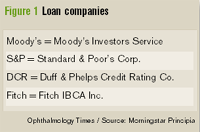Article
Reducing risks while planning for above-average returns
Author(s):
Co-editors of Money Matters attempt to outline most of the risks and rewards of bank loan funds and help answer question on how bank loan funds may be used.

Key Points
Q Could you please explain how bank loan funds work? Are they a good alternative to money market accounts?
A Before answering whether these are good alternatives to money market accounts, we would like to give some general information on bank loan funds.

Unfortunately, there remains a troubling amount of disinformation within the marketplace regarding the risks and rewards associated with such products, as well as the significant differences in the products offered by many of the industries largest mutual fund families. We will attempt to outline most of the risks and rewards of bank loan funds and help answer your question on how bank loan funds may be used.
Design and structure

In order to more effectively mitigate the risks associated with providing loans to firms with non-investment grade credit qualities, financial institutions require that the borrower provide some sort of collateral to back the loans which are being provided. The collateral can come in many forms, including fixed assets, such as real property, buildings, or equipment; intangible assets, such as patents, copyrights, or trademarks; securities in the company or its subsidiaries; and through the securitization of working capital accounts, such as inventory or accounts receivables. By being senior in stature and secured by collateral, should the borrower default on its debt obligations and enter Chapter 7 bankruptcy-whereby all of the firm's assets would be liquidated-owners of the senior secured debt would be paid before all other debt holders, preferred stock holders, and common equity shareholders.
It is important to note, however, that loans issued to those companies are not 100% asset backed, but rather are generally 50% to 80% secured by the collateral of the borrower. Therefore, in the event of default and liquidation, bondholders would not receive all their original investment upon the distribution of corporate assets. Also important to understand is that the outstanding principal of those loans will generally amortize over the agreed upon life of the loan, also known as a sinking fund provision, meaning the borrower is not only responsible for the floating rate interest payments, but also a portion of the outstanding principal.
That requirement further reduces risk as the outstanding principal is reduced, and the remaining balance of the loan approaches the value of the collateral being used to secure the issuance. Perhaps the most unique feature of those loans is their use of a floating rate of interest and ultra-short duration.





